 Image search results - "Zushi" Image search results - "Zushi" |

Ozushima island is a short boat ride from Tokuyama Port (photo) near JR Tokuyama Station. The island is known for the training ground for kaiten manned torpedoes during World War II.
|
|

Replica of a kaiten at Tokuyama Port. Note that Ozushima is not pronounced "Otsushima." Some might spell it as Ohzushima to indicate a long vowel O.
|
|
|

About the kaiten.
|
|

Tokuyama Port and boat for Ozushima island. Boat fare is 690 yen (ticket office is opposite of this dock).
|
|

High-speed hydrofoil boat for Ozushima island takes 20 min. There's also a car ferry that takes about 45 min. and the boat fare is the same.
|
|

Inside the hydrofoil boat for Ozushima island.
|
|

Tokuyama industrial complex.
|
|

Arriving Ozushima island. A facility used to train kaiten pilots still remains and the Kaiten Memorial Museum explains about the kaiten manned torpedo and the suicide kaiten pilots.
|
|

A flag on a flag pole on this hill marks the location of the Kaiten Memorial Museum.
|
|

Disembarking on Ozushima island. Be sure to check the return boat schedule since boats don't run that often.
|
|

Our boat leaving Ozushima.
|
|

Map of Ozushima. We are on the lower left of the island.
|
|

Welcome sign on Ozushima.
|
|

Memorial for kaiten pilots.
|
|
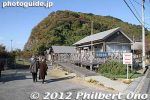
Way to the Kaiten Memorial Museum amid camp cabins.
|
|

Tourist map of Ozushima. Go right to see the Kaiten Memorial Museum or go left to see the offshore kaiten training facility.
|
|

I went to see the kaiten training facility first. The path is along the shore.
|
|

Offshore kaiten manned torpedo launch-training facility used to train kaiten pilots still remains.
|
|

Kaiten manned torpedo launch-training facility. This is where they launched practice runs around the island in manned torpedoes.
|
|

Island near Ozushima.
|
|
|

Tunnel ahead.
|
|

This World War II-era tunnel was used to take kaiten torpedoes to the training facility. It now provides access to the training facility.
|
|

Inside the tunnel leading to the kaiten training facility.
|
|

They used a trolley to transport the kaiten from the base to the offshore training facility. The trolley tracks in the tunnel have been filled in.
|
|

Trolley tracks.
|
|

An opening part way in the tunnel.
|
|

View of the kaiten manned torpedo launch-training facility.
|
|

Kaiten manned torpedo launch-training facility on Ozushima island.
|
|

The tunnel also has photos of kaiten and their suicide pilots. Very poignant and sad captions for each photo.
|
|
|

Read the caption.
|
|
|
|
|
|
|
|
|

More photos on the other tunnel wall.
|
|
|
|
|

Kaiten were launched by a submarine.
|
|
|
|
|

When you come out of the tunnel, the Kaiten manned torpedo launch-training facility is right there.
|
|

Kaiten manned torpedo launch-training facility.
|
|
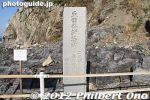
Kaiten monument
|
|
|
|

About the kaiten training site.
|
|

Kaiten manned torpedo launch-training base was built in 1939. They started using this facility for launch training from Sept. 1944.
|
|

Kaiten manned torpedo launch-training base on Ozushima island, Yamaguchi Prefecture. 回天発射訓練基地跡
|
|

The kaiten pilots trained by piloting the kaiten around the island.
|
|

Remains of the kaiten manned torpedo launch-training facility on Ozushima island, Yamaguchi Prefecture. 回天発射訓練基地跡
|
|

This facility was originally built in 1939 for testing Type 93 torpedoes. This is a launching bay for a torpedo, not kaiten which is too big for this.
|
|
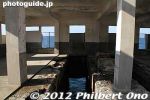
A Type 93 torpedo was 8.5 meters long and 61 cm wide. The kaiten was 14.75 meters long and 1 meter wide which is too big for this torpedo launching bay.
|
|
|
|

A torpedo launching dock. This is too small for a kaiten.
|
|

They launched the kaiten from this dock out in the ocean. They used a crane to hoist it into the water. The kaiten was 14.75 meters long and 1 meter wide.
|
|

Remains of the kaiten crane's foundation.
|
|

About the kaiten manned torpedo launch-training base built in 1939. It started to be used from Sept. 5, 1944 as a kaiten training base.
|
|
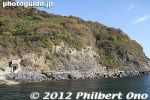
Kaiten pilots trained by driving kaitens around the island or around just the eastern part of the island.
|
|

Way back to the tunnel.
|
|

Way to the Kaiten Memorial Museum. It's slightly up the hill.
|
|

Now the Ozushima Primary School, this was where they had the military barracks for kaiten personnel. They transported the kaiten from here to the offshore launch-training facility.
|
|

Forest for international exchange.
|
|

Path to Kaiten Memorial Museum.
|
|
|

Kaiten Memorial Museum on Ozushima island, Yamaguchi Prefecture. Open from 8:30 am to 4:30 pm. Closed Wed. Admission 300 yen. Free for kids under age 18. 回天記念館
|
|

The Kaiten Memorial Museum has a full-scale replica kaiten torpedo on display right outside.
|
|

The Kaiten Memorial Museum has a full-scale replica kaiten torpedo on display right outside.
|
|

Kaiten manned torpedo replica outside the Kaiten Memorial Museum on Ozushima island, Yamaguchi Prefecture.
|
|
|
|

Periscope of kaiten.
|
|
|
|
|
|
|
|

Kaiten pilot seat inside the kaiten.
|
|
|
|

Kaiten engine remnants.
|
|

Kaiten engine remnants.
|
|

Kaiten engine remnants.
|
|
|
|

Monument for kaiten pilots who died.
|
|
|
|

Names of kaiten pilots who died.
|
|
|
|
|

Memorial bell
|
|

View of Seto Inland Sea from the museum.
|
|
|
|

Inside the Kaiten Memorial Museum.
|
|

Photography is allowed inside the museum, but they don't allow you to take pictures of the wall of portraits of those who died as kaiten pilots.
|
|
|
|
|
|
|
|
|
|
|

Scale model of wartime Ozushima island.
|
|
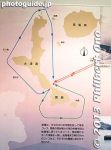
Kaiten training routes around Ozushima. The pilots trained by driving the kaiten around the upper or lower half of the island or navigating in a straight line for 3 km. The launch site is on the lower left.
|
|
|
|
|
|

Replica of kaiten's pilot cockpit.
|
|

Replica of kaiten's pilot cockpit seat.
|
|

Replica of kaiten's pilot cockpit.
|
|
|
|

Kaiten mounted on a sub for launching.
|
|
|
|
|
|
|
|
|

Final testaments by kaiten pilots on suicide missions. They were only 18-20 years old.
|
|
|

Exhibits in the Kaiten Memorial Museum.
|
|
|
|

Kaiten hatch.
|
|
|
|
|
|
|
|
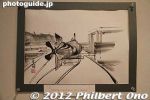
Drawing of a kaiten being transported to the test launching site on Ozushima.
|
|
|
|

Drawing of a submarine loaded with kaiten sailing away from Ozushima with a seaplane overhead.
|
|

Museum's founder, Katsuro Mori who collected many kaiten-related artifacts for the museum.
|
|

Back to the port.
|
|

Car ferry back to Tokuyama Port.
|
|

Car ferry back to Tokuyama Port. It takes about 45 min. to Tokuyama Port from Ozushima.
|
|

Leaving Ozushima.
|
|
|

Kaiten Memorial Museum can be seen on this hillside with the flag pole.
|
|
|

When visiting Toyooka, visiting Izushi is also highly recommended. Short bus ride from JR Toyooka Station to the Izushi bus stop here.
|
|

In Japanese, Izushi is written as 出石 which we may normally pronounce in other ways. So even the local bus makes its clear with hiranaga on how it's pronounced. Very unusual pronunciation.
|
|

The Izushi bus stop is conveniently located near Izushi Castle.
|
|

Way to Izushi Castle and Shinkoro Clock Tower.
|
|

Izushi's symbol is the Shinkoro Clock Tower. This area is also a National Important Traditional Townscape Preservation District (重要伝統的建造物群保存地区). 辰鼓楼
|
|

Shinkoro Clock Tower in Izushi, Toyooka, Hyogo Prefecture is one of Japan's oldest clock towers along with the Sapporo Clock Tower also built in 1881. 辰鼓楼
|
|

Shinkoro Clock Tower in Izushi, Toyooka, Hyogo Prefecture is one of Japan's oldest clock towers along with the Sapporo Clock Tower also built in 1881. 辰鼓楼
|
|

Shinkoro Clock Tower was first built in 1871 without any clock. 辰鼓楼
|
|

Shinkoro Clock Tower was orignally used to beat taiko drums from 7 am to 9 am to notify people that the castle lord arrived at the castle. A mechanical clock from the Netherlands was later donated by a local doctor to make it a clock tower in 1881. 辰鼓
|
|

About the Shinkoro Clock Tower. 辰鼓楼
|
|

Manhole with Shinkoro Clock Tower design in Izushi, Toyooka, Hyogo Prefecture.
|
|

Manhole with Shinkoro Clock Tower design in Izushi, Toyooka, Hyogo Prefecture.
|
|

Izushi Castle in Toyooka was built in the early 17th century. No original structures remain except for the stone walls and foundations. Reconstructed turrets and a small shrine are on the castle grounds. 出石城
|
|

Tojobashi Bridge to Izushi Castle's Tojomon Gate. 出石城 登城門・登城橋
|
|

Castle moat.
|
|

Izushi Castle is on a low hill. Only some steps to climb.
|
|

Some stone walls and foundations still remain.
|
|
|

Pulling out weeds from the stone wall.
|
|

Stone work on Izushi Castle.
|
|
|

Reconstructed West Corner Turret. 西隅櫓
|
|

Reconstructed West Corner Turret. 西隅櫓
|
|
|

Reconstructed West Corner Turret. 西隅櫓
|
|
|

Reconstructed West Corner Turret is not open to the public. 西隅櫓
|
|

Castle wall.
|
|

East Corner Turret.
|
|

East Corner Turret.
|
|

East Corner Turret.
|
|
|

Izushi Castle's Honmaru
|
|

Izushi Castle's Honmaru has a large stone foundation for the main tower,
|
|

Izushi Castle's Honmaru has a large stone foundation for the main tower,
|
|

Izushi Castle's Honmaru has a large stone foundation for the main tower,
|
|
|

Izushi Castle's West Corner Turret.
|
|
|
|
|
|

Entrance to the path of torii gates to Ariko-yama Inari Jinja Shrine atop Izushi Castle's main foundation. 有子山稲荷神社
|
|
|
|

Torii gates to Ariko-yama Inari Jinja Shrine atop Izushi Castle's main foundation. 有子山稲荷神社
|
|

There are over 30 torii gates to the shrine.
|
|

The torii gate path goes along the east side of Izushi Castle.
|
|
|
|
|
|
|

Ferns and trees make the place solemn.
|
|

Ariko-yama Inari Jinja Shrine atop Izushi Castle's main foundation. 有子山稲荷神社
|
|

Ariko-yama Inari Jinja Shrine atop Izushi Castle's main foundation. 有子山稲荷神社
|
|

Ariko-yama Inari Jinja Shrine atop Izushi Castle's main foundation. 有子山稲荷神社
|
|

Atop Izushi Castle's main foundation also gives great views of Izushi.
|
|

Views of Izushi.
|
|

Views of Izushi from Izushi Castle.
|
|

Views of Izushi from Izushi Castle.
|
|

Shinkoro Clock Tower as seen from Izushi Castle.
|
|

Japanese pine tree.
|
|

Going back down through the torii gates.
|
|
|
|
|
|

On Nov. 3, Izushi holds the Oshiro Matsuri to reenact the daimyo procession.
|
|
|

Izushi Town Hall
|
|

Gift shop in Izushi.
|
|

Gift shop in Izushi.
|
|

Samurai residence.
|
|

About the Samurai residence.
|
|

Izushi soba is famous for having cold soba served on five small plates. Dip the noodles in the broth while adding different garnishes like grated yam, onions, and raw egg. 出石そば
|
|

Lots of soba restaurants in Izushi. This lunch cost ¥870. You can also order more plates of noodles. The history of Izushi soba goes way back to the early 18th century when the local lord brought it from Nagano (Shinano soba). 出石そば
|
|

These five plates are not much for the average stomach. It was a good snack. 出石そば
|
|

Izushi also has Eirakukan (永楽館), the Kansai Region's oldest kabuki theater built in 1901. It closed in 1964 due to the spread of television and other diversions.Years later, the theater was renovated and reopened in 2008. The theater puts on performances occasionally.
|
|

Eirakukan (永楽館), the Kansai Region's oldest kabuki theater built in 1901. Toward the left was the theater's front entrance that is not used anymore because of the road right in front. They now use a side entrance.
|
|

The theater's original front entrance that is not used anymore because of the road right in front. They now use a side entrance.
|
|

The theater is in Izushi's National Important Traditional Townscape Preservation District (重要伝統的建造物群保存地区).
|
|

Theater entrance on the side. The theater is a short walk from the Izushi bus stop and Izushi Castle.
|
|

You have to take off your shoes.
|
|

Theater lobby.
|
|

Theater lobby.
|
|

Inside Eirakukan. You can freely tour inside the theater. Very impressive and rare glimpse of a Meiji Period theater. That's the hanamichi on the left. You can walk on it too.
|
|
|

The hanamichi on the left. You can walk on it too.
|
|

The hanamichi on the left. You can walk on it too and feel like a kabuki actor...
|
|
|
|

Eirakukan Theater in Izushi, Toyooka, Hyogo.
|
|
|

Stage as seen from the back row.
|
|

Side seats.
|
|
|
|
|
|
|
|

Advertising posters on the walls.
|
|

Very retro.
|
|

The revolving stage (mawari-butai). Above the stage in the back are dressing rooms for the performers. Normally hidden by a curtain.
|
|

Eirakukan's rotating kabuki stage.
|
|

Rotating kabuki stage.
|
|

View from the stage.
|
|
|
|
|
|

Stage curtains.
|
|

Booth for instrument players.
|
|

Inside a booth for instrument players.
|
|

Backstage has the dressing rooms for actors. Normally hidden by a curtain.
|
|

Dressing room.
|
|
|
|